Cruz Azul are in the midst of one of the most exciting in-season renaissance stories in football at the moment.
La Maquina endured a torrid first half of the Mexican league season in the Liga Apertura, finishing 16th among 18 teams after winning just five games and losing 10.
After they began their campaign with three losses, the club initially sacked manager Ricardo Ferretti, replacing him with assistant manager Joaquin Moreno, who notably played 120 times for them during his playing career.
However, the team laboured to just five wins from Moreno’s 14 matches in charge, resulting in another managerial change.
Cruz Azul then chose to bring in Martín Anselmi, who had just resigned from his role at Independiente del Valle after over a year and a half in charge.
Under the Argentine tactician, the Mexican club have endured a start few could have anticipated, racking up five wins and a draw in seven matches to sit atop Liga Clausura.
Their uptick in form can be attributed to a solid defence that has conceded just three times, but their attack has also performed, with the team scoring 10 goals.
What has led to Anselmi drastically improving the team’s fortunes?
This Martín Anselmi tactical analysis report will dive into the changes he has brought about, along with some analysis of Cruz Azul’s tactics, performances and players who have improved.
(Note: This report does not take Cruz Azul’s 3-2 win over Club León on February 22, 2024 into account)
Martín Anselmi Background
Anselmi is only 38 but already boasts extensive managerial experience.
His coaching career began in 2015 with the youth teams at Atletico Excursionistas and Comisión de Actividades Infantiles.
He then became Gabriel Milito’s assistant manager at Atletico Independiente in the summer of 2016 but held that position only until the end of that year.
Anselmi received another assistant manager gig at Uruguayan second-tier side Club Atletico Atlanta in July 2017 and remained there for nearly a year before getting his first managerial appointment at CD Universidad Católica B.
A year later, he joined Independiente del Valle in Ecuador as assistant manager to Miguel Ángel Ramírez.
The duo left the club in December 2020 before joining forces once again at Internacional three months later, with that lasting until that summer.
Anselmi then became the manager of Chilean first-tier team Unión La Calera in January 2022 but lasted just four months as they won just three of his 15 matches in charge. However, they also lost only four, playing out eight draws.
In May of that year, he returned to Independiente del Valle, this time as their first-team manager. This time around, Anselmi made the most of his chance, as the team won five and drew one of his first six matches in charge.
In October 2022, he won the first senior title of his career as Independiente beat São Paulo 2-0 in the Copa Sudamericana final.
A month later, he let them win the Copa Ecuador title with a 3-1 win over AD 9 de Octubre in the final.
February and March 2023 brought two more titles as Independiente defeated SD Aucas (3-0) and Flamengo (5-4 on penalties, 1-1 on aggregate) in the finals of the Supercopa Ecuador and Recopa Sudamericana.
Meanwhile, he led them to a second-placed finish in the 2022 Serie A Segunda Etapa before following it up with a table-topping display in the 2023 Serie A Primera Etapa, winning 20 and drawing three of 30 combined games across both competitions.
However, Independiente’s form dipped in the 2023 Segunda Etapa as they won just six of their 15 matches to finish eighth.
They then lost the finals of the Tercera Etapa on penalties (4-1, 1-1 on aggregate), which marked their sixth successive game without a win, after which Anselmi departed the club.
Cruz Azul: Key Statistical Changes Under Martín Anselmi
This section must be prefaced by some surface-level stats involving Cruz Azul.
La Maquina‘s performances over the last six seasons (2023/24 included) suggest that they generally tend to do better in the Clausura than in the Apertura.
Between 2018/19 and now, they have averaged a higher win percentage (57.89% vs 40.90%) and lower loss percentage (21.17% vs 34.04%), as well as more goals scored (1.55 vs 1.38) and fewer goals conceded (0.94 vs 1.19) per game in the Clausura than in the Apertura.
However, rather interestingly, three of the five completed seasons saw them finish higher in the Apertura than in the Clausura.
In the two seasons they didn’t do that (2019/20 and 2020/21), they finished first in the Clausura, a trend Anselmi will hope to continue.
This still shouldn’t take away from what Anselmi has done, however. Cruz Azul hold a win percentage of 71.4% so far in the Clausura this term, more than what they’ve managed in each of the last six Apertura seasons and four of the last five Clausura seasons.
Their goals per game of 1.43 is also more than all but two seasons each in the Apertura and Clausura, while their goals conceded per game at 0.43 is their lowest in the Clausura across the last six seasons and was bettered only once in the Apertura (0.35 in 2020/21).
Digging deeper into the underlying stats also shows marked improvement across the board in the Clausura compared to their 2023/24 season average, which itself has undoubtedly been helped by their incredible shift in form in the new year.
As the table below shows, Cruz Azul are performing better in expected goals (xG) and shots per game while recording a massive uptick in penalty area entries per game.
Their shot accuracy has dropped with more attempts from outside the area, but their average shot distance is more or less the same.
Additionally, they were a much more potent counter-attacking team previously.
Under Anselmi, however, a higher percentage of their positional attacks result in shots instead, indicating a shift in tactics entirely.
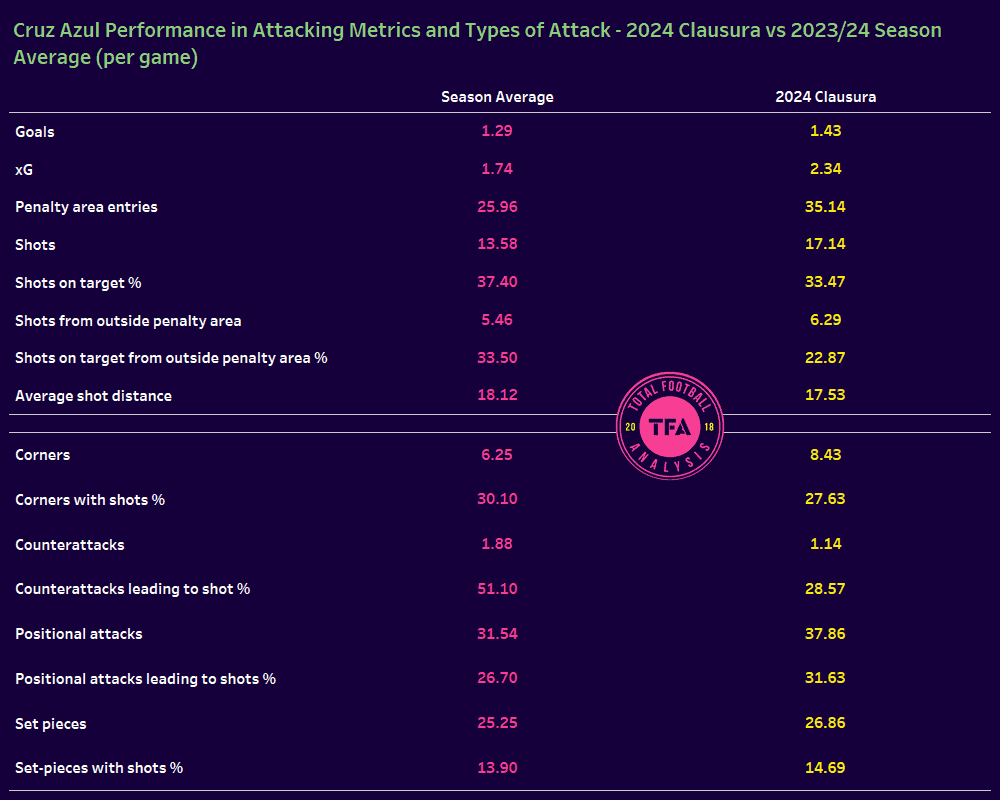
The table below also suggests the change in the tactical approach mentioned above, as Cruz Azul are averaging more possession per game under Anselmi than their season average, with a higher number of passes per possession per game.
This has, in turn, fed into more forward passes with a marginally improved accuracy and more passes into the final third, as well as better crossing and more deep completed passes per game.
Their progressive passing numbers have also shown a marginal improvement.
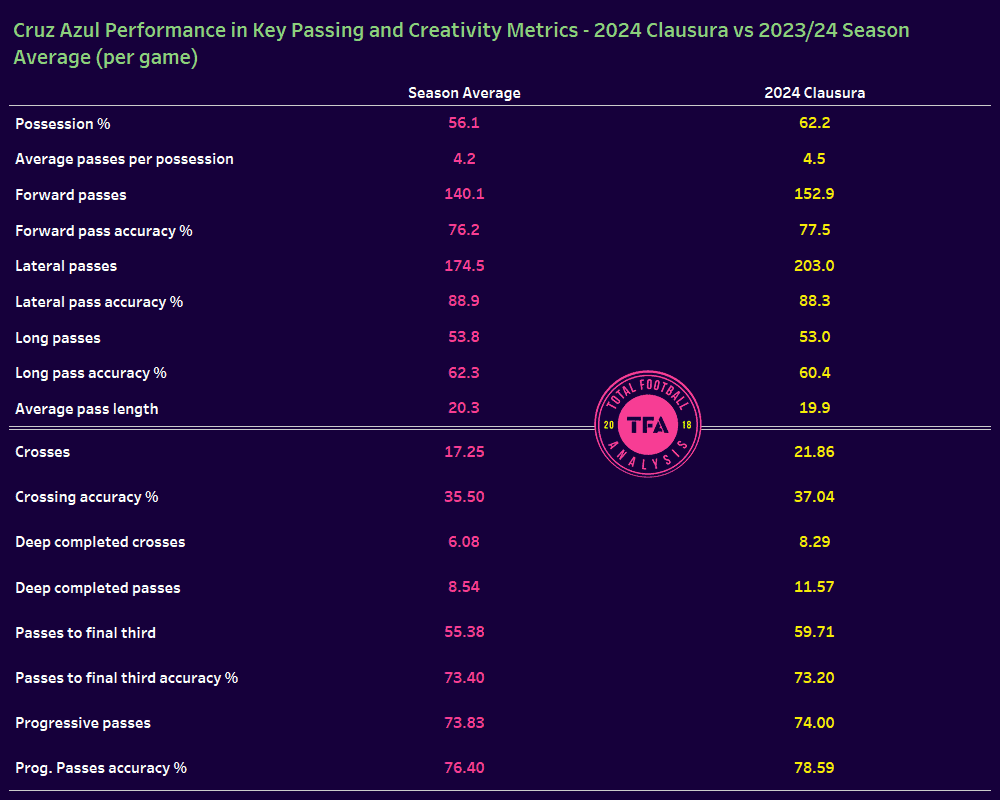
Anselmi’s impact has also been felt on the defensive end, starting with their passes per defensive action, which has dropped drastically to 7.5, indicating a more aggressive pressing system.
La Maquina are also allowing substantially fewer shots and shots on target per game while committing fewer fouls and recording more interceptions and recoveries, indicating increased compactness. Their slide tackling has improved as well.

All of this combined shows that it’s not taken long for Anselmi to stamp his authority on this team and get them in line with his vision for Cruz Azul.
Their improvements across all three facets of the game have led to a massive change in fortunes, driven by their manager, who has altered their style of play almost entirely.
Martín Anselmi Style Of Play – Set-up, Pressing and Defensive Solidity
Martín Anselmi Formations and Personnel
Before we get into Cruz Azul’s attack, it’s important to stress the amount of improvement their defence has shown.
Prior to Anselmi’s arrival, the team conceded 1.71 goals per game in the Apertura, with that figure dropping by 83.6% in the Clausura, albeit in fewer games played.
The improvement has not been driven by consistency in set-up, with Anselmi choosing to switch between multiple formations.
As per Wyscout, he has only repeated a formation (4-3-3) once across his seven games in charge, with five different formations in the other five matches (4-1-4-1, 3-4-3, 3-5-2, 5-3-2, 3-4-1-2).
In the January transfer window, Anselmi oversaw the purchase of six players – goalkeepers Kevin Mier and Luis Jiménez, left-backs Camilo Cándido and Gonzalo Piovi, midfielder Lorenzo Faravelli and centre-forward Gabriel Fernández.
They joined from Atletico Nacional, Necaxa, Club Nacional, Racing Club, Anselmi’s old employers Independiente and UNAM Pumas, respectively.
Apart from the two goalkeepers, the remaining four players are in the 28-30 age range, adding much-needed experience to the squad.
Mier has quickly taken over the spot in goal, starting all seven of Cruz Azul’s Clausura matches so far.
Piovi has featured as both a left-back and left centre-back according to the formation, with Carlos Vargas and Cándido also playing in those positions when required.
Willer Ditta has primarily played as the other centre-back. Club captain Ignacio Rivera has operated in the right-back and right centre-back positions as and when required.
Carlos Rotondi has been deployed as a left winger or left wing-back so far by Anselmi.
At the same time, Rodrigo Huescas and Uriel Antuna have taken up the right wing-back spot, though the latter has also been played as a right winger and as a right-sided centre-forward.
Carlos Rodriguez and Faravelli have been consistent starters in midfield, with Erik Lira, though Fernández, despite being a centre-forward, and Alexis Gutiérrez has also received the odd start.
Lastly, Fernández has been the most consistent starter up front and has been joined by Ángel Sepúlveda in two-striker formations, though the latter has also played up front alone or with Antuna.
Martín Anselmi Defensive Shape and Pressing
Despite the numerous formation changes, Cruz Azul have followed similar principles with respect to their defensive shape and pressing, which becomes evident when we look at sequences from their matches.
Consider the following play from their latest match, a 1-0 win over Tigres in which they lined up in a 3-4-1-2 formation.
Here, as Tigres play the ball to a centre-back, one of the forwards prepares to press him, with the ball then being played to a midfielder.
From here, we see the shape that Cruz Azul use with a high defensive line, two pressers cutting out the ball over the top and to the left and two players retreating to make up the numbers in case Tigres work through the press.
One of the centre-forwards also starts making his way back.
In the bottom-left frame, we notice that one of the Cruz Azul players is late to press a Tigres player who comes short, enabling a pass to the left-back, who in turn finds the left-winger.
Here, we have a good final sense of their shape when the opposition has the ball in attack as well.
Anselmi’s side now track back as a five-man defensive line, while two midfielders also track back.
They leave the opposite flank open, baiting an ambitious switch while getting enough men back to deal with crosses into the box.
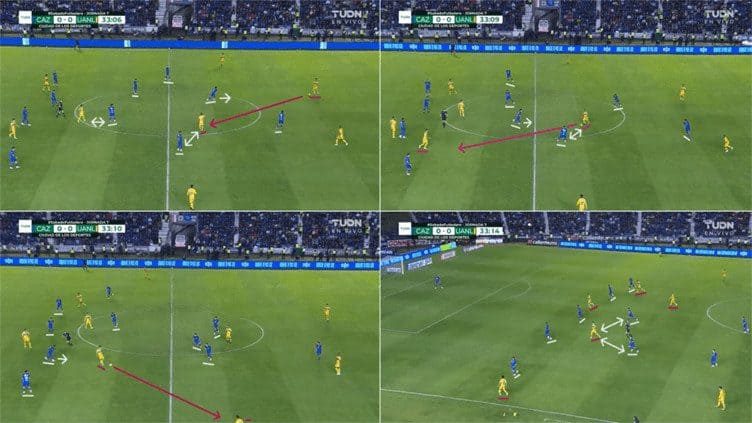
A similar pressing system can be seen in their 0-0 draw with Juarez, where they lined up with a four-man defence.
Cruz Azul commits five men to the press, but Juarez are better at beating the first line of defense than Tigres.
This was one of Anselmi’s first matches in charge, and we also see a slight communication breakdown in the bottom-right panel as the opposing midfielder is allowed to move forward with the ball.
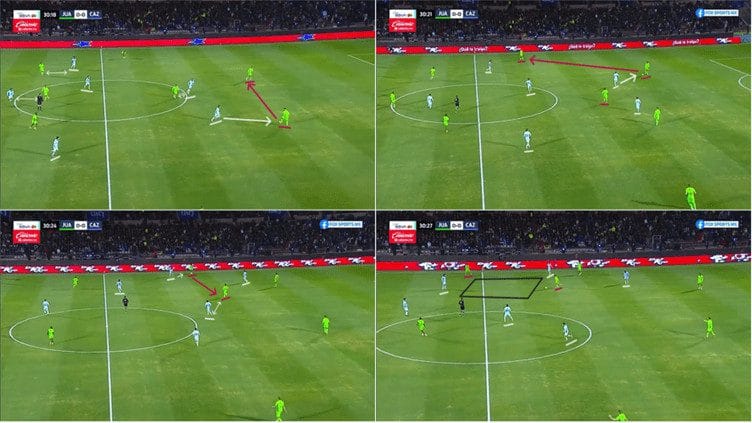
The Juarez midfielder finds the right-sided attacker, who cuts inside before passing it back to the left centre-back.
The ball is then moved to the left wing and we see a Cruz Azul midfielder (marked in black) initially steps out to press the wrong man before quickly changing direction.
He recovers in time to press the man in possession, ultimately forcing a pass back to the defence.
Ultimately, while this is a four-man backline, we still see a similar spread of the last defensive line staying in one line with the holding midfielder ahead of them.
The two wide forwards and central midfielders make up another line, with the centre-forward dropping back after pressing the opposition.
This gives them numerical superiority close to the box and in midfield.
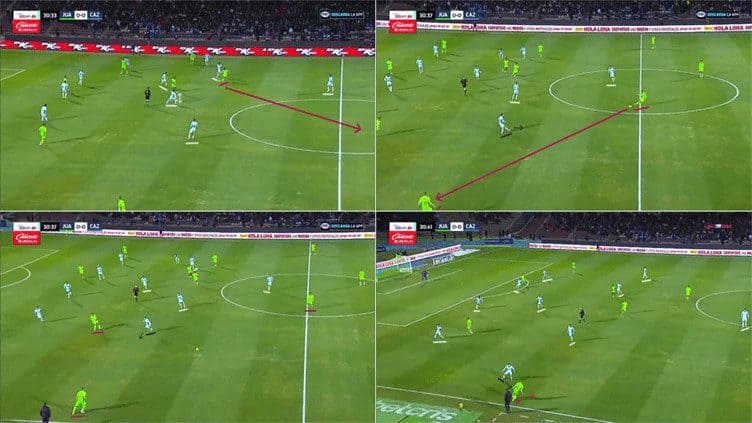
While Cruz Azul do commit players to press high up the pitch, their ability to drop back according to the situation and get into a defensive shape that is tough to break down deserves credit. This combination has been drilled into the players by Anselmi and is a big reason for their excellent defensive record.
It’s also worth noting here that of the three goals they have conceded, one took multiple unfortunate deflections, another was an error in defence, and the third was a stunning finish from the edge of the box. While there were a couple of errors leading up to these goals, overall, they have been fairly resolute at the back.
Martín Anselmi Attack – Where are the goals coming from, and how?
It’s a short sample size so far, but Cruz Azul’s attack under Anselmi has fired.
Six out of their 10 goals have come from their forwards, with Fernández, Sepúlveda and Antuna scoring two apiece.
Wingers Rotondi and Huescas and captain Rivero have scored one goal each.
An own-goal by Tigres’ Diego Reyes completes their 10-goal haul in seven Clausura matches this term.
Before we get into their goals, it’s essential to understand the patterns that emerge in their build-up play.
Given the often lineup with a three-man backline, Anselmi’s side can construct moves by spreading out their centre-backs and pushing the wing-backs up the pitch.
This creates much-needed numerical superiority in midfield or in attack, depending on how far up the pitch the defence can take the ball.
Consider this sequence from their match against Atlético de San Luis.
The three centre-backs spread themselves across the halfway line, with the left wing-back staying back but out wide to support the move, while two midfielders are closely marked by the opposition.
The third drops back to receive a pass, with the two forwards upfront occupying the opposition defenders and the right wing-back staying high and wide for a switch.
Cruz Azul play the pass into midfield but sees no openings and continues passing around the back, patiently waiting for an opening.
In the bottom-right panel, one of the midfielders finally has space to run into, and two smart passes from here along the wing could open up the right flank for them.
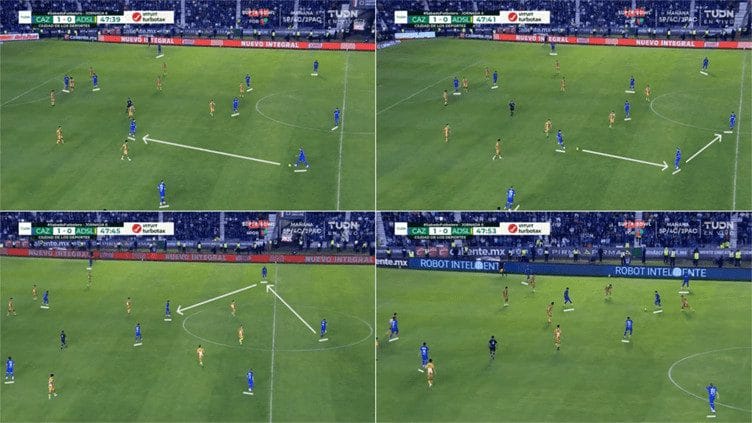
They are also capable of moving the ball far quicker with excellent link-up play against teams that don’t overload the middle of the park, though, as evidenced by Sepúlveda’s strike against Club Tijuana.
The goal is an example of how it helps Anselmi’s side to have a player constantly out wide, thus stretching play and opening up space for midfield runners.
In this simple sequence, the centre-back gets the pass from a quick free-kick, saunters forward and finds the left wing-back out wide.
Both of them draw defenders, thus opening up space for Gutiérrez to run into.
He then squares it into the box, where Fernández pulls a defender towards him with a run to the near-post, allowing an unmarked Sepúlveda (marked in black) to blast home.
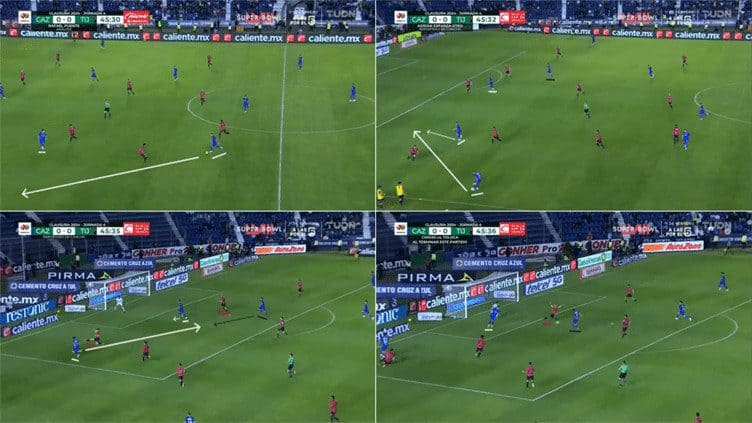
The concept of willing midfield runners has also helped Cruz Azul often find space for a pass that doesn’t seem on initially, with their off-the-ball movement proving to be one of their strongest assets under Anselmi.
Consider this strike by Fernández against Querétaro, where a midfielder moves towards the left after intercepting a clearance.
However, under pressure, he turns his marker before spotting Rivero (marked in blue), who sneaks back into space in midfield after going forward during the initial sequence that led to the clearance and is now turned towards goal once again.

Once he is found, Rivero does well to find Fernández, who gets in front of his defender and takes a touch before finding the back of the net from close range.
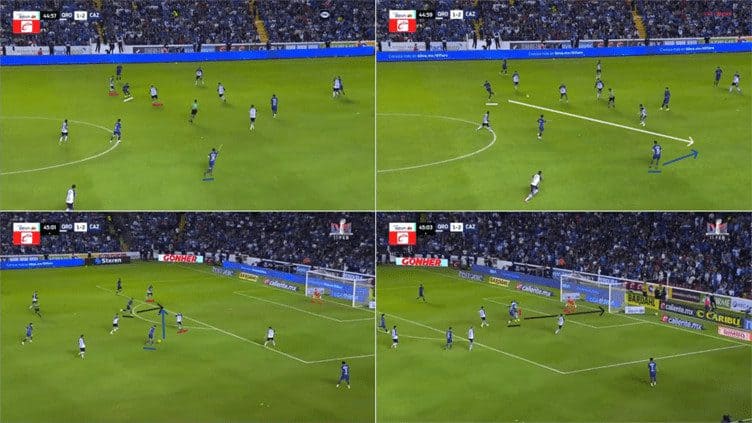
Cruz Azul’s attacks are thus built on spreading the play out, starting with defence, achieving numerical superiority in key areas and then supplying the finishing touch more often than not.
Conclusion
It hasn’t been too long, but Martín Anselmi has accomplished quite a bit in his short stint so far at Cruz Azul.
La Maquina are playing with clarity and confidence in attack while maintaining an excellent defence that seldom lets opponents through.
Under Martín Anselmi tactics, the team’s improvement has been unprecedented, and it will be a challenge to keep this up.
However, all that matters for now is that they’re atop the Clausura and firing on all cylinders!





Comments